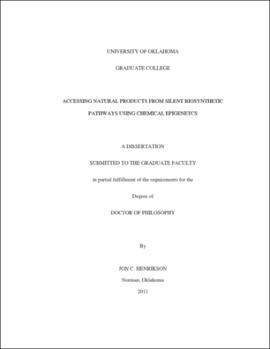| dc.contributor.advisor | Cichewicz, Robert H | |
| dc.creator | Henrikson, Jon C. | |
| dc.date.accessioned | 2019-04-27T21:31:47Z | |
| dc.date.available | 2019-04-27T21:31:47Z | |
| dc.date.issued | 2011 | |
| dc.identifier | 99272803602042 | |
| dc.identifier.uri | https://hdl.handle.net/11244/318924 | |
| dc.description.abstract | Natural products have played a major role in the history of medicine. Despite this history, many view the area of natural products discovery to be tapped dry, thus the focus of drug development companies has shifted towards other avenues to discover new drug leads (i.e. combinatorial chemistry). In recent years, there has been an expansion of antimicrobial-resistant organisms accompanied by a lack of new drug entities coming to market. These trends illustrate a need to find new approaches other than the current status quo. | |
| dc.description.abstract | Analyses of microbial genomes show that there are many more secondary metabolite biosynthetic pathways than known secondary metabolites. These silent biosynthetic pathways (SBPs) offer the opportunity to discover new chemistry and the hope of new drug-like entities. Current methodologies to access SBPs fall into one of two categories: culture-dependent methods or molecular-based techniques, which are highlighted in chapter 1. While both approaches have been utilized to access SBPs, there are many deficiencies which inhibit the overall effectiveness of both methods. We offer another approach to bypass these difficulties. Studies of fungal genomes have demonstrated that many secondary metabolite biosynthetic genes are under epigenetic regulation. It is thought that treating fungi with small molecule epigenetic modifiers will upregulate the transcription of SBPs and allow the isolation of new secondary metabolites. This dissertation describes the work done using small molecules epigenetic modifiers to access SBPs and isolate new secondary metabolites. The third chapter involves pilot studies of cultures which were treated with epigenetic modifiers and the resulting isolation of two new polyketide compounds, lunalides A and B. The fourth chapter follows up this work by demonstrating that the use of epigenetic modifiers results in the transcriptional upregulation of secondary biosynthetic pathways for a well-studied strain of Aspergillus niger. This is followed by the isolation of nygerone A from Aspergillus niger in the fifth chapter, which also presents a structural revision and bioactivity analysis of a set of γ-pyrones and γ-pyridones. The final chapter diverges from the topic of small molecule epigenetic modifiers and investigates the ichthyotoxicity of Prymnesium parvum, an invasive algal species which has transitioned from coastal water regions to local rivers, lakes, and streams. | |
| dc.format.extent | 219 pages | |
| dc.format.medium | application.pdf | |
| dc.language | en_US | |
| dc.relation.requires | Adobe Acrobat Reader | |
| dc.subject | Natural products | |
| dc.subject | Biosynthesis | |
| dc.subject | Pharmacognosy | |
| dc.title | Accessing Natural Products from Silent Biosynthetic Pathways Using Chemical Epigenetics | |
| dc.type | text | |
| dc.type | document | |
| dc.thesis.degree | Ph.D. | |
| ou.group | College of Arts and Sciences::Department of Chemistry and Biochemistry | |
